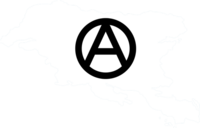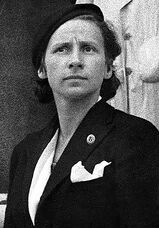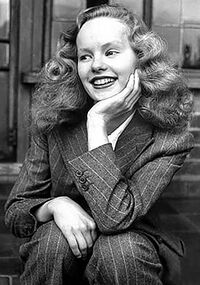Anarchism in Gylias
| Anarchism in Gylias |
|---|
 |
 |
|---|
| This article is part of a series on the politics and government of Gylias |
Anarchism in Gylias has been a major presence and contributor to Gylian society and politics. Gylias has had one of the strongest anarchist movements in Tyran, with a rich history and important role in Gylian life.
Numerous variants of anarchism exist in Gylias, some notably overlapping with communism and socialism. The predominant current is social anarchism, with a significant individualist minority. The defining characteristic advocating the replacement of the state and unjust hierarchies with self-managed, self-governed societies based on voluntary, cooperative institutions.
Anarchism is situated on the left to far-left of Gylian politics. Numerous parties and formations represent it at the federal level, including the Democratic Communist Party, Democratic Left, and Labour Solidarity League in the Progressive Alliance, the Freedom and Solidarity Party in the Liberal Union, and the Free and Voluntaryist Union, Love, Nature, Democracy, LSD Party, People Power-Citizens' Movement, Rally for a Free Society, and Union of Independents among Non-inscrits.
Terminology
Historically, anarchists have fought with statists and similar currents for primacy within the communist and socialist movements. As a result, "anarchist" or "libertarian" are common descriptor labels attached to other ideologies.
Anarchists without adjectives and synthesis anarchists have criticised the use of different qualifying labels for various schools of thought, preferring to be known simply as "anarchists".
Characteristics
Gylian anarchism advocates the abolition of the state and unjust hierarchies, to be replaced with self-managed, self-governed societies based on voluntary, cooperative institutions. Some describe these institutions as stateless societies, while others call them free associations.
The flexibility of the anarchist philosophy has allowed it to attain presence and influence over Gylias' major political movements and ideologies. Such has been their success that even the Gylian far-right has adopted an anarchist veneer for their worldview.
Prefigurative politics and social revolution are major themes of anarchism, which accordingly takes strongly libertarian stances on social issues, and advocates decentralisation, localism, and subsidiarity politically. Owing to their utopian current, Gylian anarchists have made major contributions to social philosophy and political culture, championing "everyone's right to beautiful, radiant things".
Variants
Several parties exist that represent anarchism at the federal level, although some refuse to label themselves "parties", preferring other terms like "union", "movement", or "rally". They are not concentrated in a single electoral bloc, but rather dispersed among various blocs.
In the Progressive Alliance, the Democratic Communist Party strives to be the main vehicle for anarcho-communism, the Democratic Left emphasises council communism, and the Labour Solidarity League anarcho-syndicalism. In the Liberal Union, the Freedom and Solidarity Party represents left-wing market anarchism and mutualism.
A diverse range of anarchist beliefs is present among Non-inscrits, including the centre-right market anarchist tradition (Free and Voluntaryist Union, Rally for a Free Society, Union of Independents), synthesis anarchism (People Power-Citizens' Movement), anarcho-naturism (Love, Nature, Democracy), and acid communism (LSD Party).
Due to the broad overlap of communism, socialism, and anarchism, formations that can be considered anarchist or anarchist-allied include the libertarian socialist Socialist Party and the eco-socialist Green Party. The ideology of the Pirate Party also shares common interests and preoccupations with anarchism.
Left anarchism
Gylian anarchism is dominated by collectivist and social currents. The major forms of leftist anarchism are anarcho-communism, libertarian socialism, and anarcho-syndicalism.
All three strands are united by their advocacy of cooperativism and the end goal of abolishing money. Differences arise over strategies, tactics, and plans for a moneyless society.
Anarcho-syndicalism has been a major current in the Gylian labour movement, and has a strong presence in the General Council of Workers' Unions and Associations.
Right anarchism
Individualist anarchism forms a significant minority in Gylian anarchism, with its own historical tradition and a colourful role in Gylian politics. The term "right anarchism" is used to contrast with the more collectivist orientation of social anarchism: Gylian individualist anarchism remains firmly on the left by any measure.
The most famous manifestation of the current is market anarchism, which advocates free markets in the context of abolition of capitalism and the state, incorporating elements of mutualism and agorism. To avoid confusion with the capitalist use of "free market", market anarchists prefer Iana Rynai's term "emancipated markets" to describe their ideal.
Market anarchists are renowned for cultivating an image of androgynous, decadent glamour strongly inspired by Weimar culture, which has made them a famous eccentric presence in mainstream politics.
Conservatives and liberals have also made notable use of the individualist tradition to adapt to the radical changes in Gylian politics, giving rise to some currents of "anarcho-conservatism" and "anarcho-liberalism".
Lifestylism
Lifestylism or "lifestyle anarchism" is a label used for anarchists who put more emphasis on social revolution, prefigurativism, and culture or identity than economics or politics. The label is mostly used humorously, although some social anarchists have used it to criticise the current's lack of commitment to revolution.
Lifestylist currents include anarcho-naturism and anarcho-primitivism. The schools of anarcha-feminism and queer anarchism as a whole are not considered part due to their strong anti-capitalist focus, but some subgroups of it can be considered lifestylist.
Several strongly progressive and libertarian aspects of Gylian society — especially gender and sexuality, pornography, sex work, and drugs — are the focus of currents that emphasise their role in the liberation of the individual and construction of a stateless society. These have received humorous nicknames such as "pornmunism", "acid communism", "sexarchism". "Cyberanarchism" is another notable one.
Acid communism is perhaps the best-known lifestylist strand. It emphasises the utopian and experimental sensibilities of radicalism, and the emancipatory role of psychedelic drugs, which can serve as a tool of progress, personal development, and the construction of solidarity.
Among Gylian anarchists, acid communism has had the strongest concentration on the role of drugs and popular culture in social revolution, and thus has had a significant impact on popular culture and the arts, through exploring and organising the solidarist, collective elements of the avant-garde, dance culture, and nightlife.
Others
Gylian anarchists do not consider capitalism compatible with anarchism at all, and thus the term "anarcho-capitalism" is rejected and its adherents ostracised. "Right-libertarianism" is also strongly circumscribed or used pejoratively, prefaced by soi-disant. It is dismissed as an attempt by right-wingers to hijack the leftist tradition of libertarianism.
"Anarchaos" is the label used for a post-anarchist and egoist tendency that emerged in the 1960s. It made minor contributions by originating the concept of temporary autonomous zones, which would later be developed by acid communism. "Anarchaotics" were involved in founding the LSD Party, although they were expelled quickly due to factional conflict.
The Gylian far-right has attempted to use anarchist rhetoric and imagery to further its ideology, which is resisted by anarchists.
History
Ideas resembling anarchism have a long history in Gylias, dating back to the Liúşai League. The extent to which League societies reflected primitive communism is a matter of debate among historians and leftist thinkers. However, broad "anarchic elements" are accepted to have been present in League societies, including common ownership of land, relatively horizontal political structure and absence of classes, and an ancient tradition of direct democracy.
Xevden
The experience of oppression, discrimination, and impoverishment under Xevden was the main catalyst for the development of anarchist thought in the 19th century.
The emergence of anarchism is intertwined with those of socialism and communism. Anarchists mainly emerged out of the "confrontationist" faction of the Gylian opposition, after the revolutions of 1848 and 1856–1868, taking a more revolutionary and insurrectionist stance.
Anarchism played a key role in the Gylian ascendancy, particularly in the creation of mutual organisations and cooperatives to improve Gylians' economic condition. They were also involved with the kyðoi, whose transformation from native bandits and guerrilla fighters into modern freedom fighters occurred through the influence of individualist anarchism and illegalism.
Informal anarchist movements developed in Xevden, giving them a presence in the "constitutionalist" faction of the Gylian opposition. Through the revolutions of 1848 and 1856–1868, they established links with communists, socialists, and liberals.
The establishment of the Ruvelkan Socialist Republic in 1867, one of the first explicitly socialist states in Tyran, had a galvanising impact on the broader Gylian left. Gylian anarchists looked to Ruvelkan anarchists as important allies and models, and the gradual split between anarchists and communists in Ruvelka was reflected in the anarchist–libertarian and statist–authoritarian battles over supremacy in the communist and socialist movements.
King Karnaz's 1902 coup and subsequent repression caused anarchists, communists, socialists, and other radicals to gain ground at the expense of conservatives and liberals in the ensuing disintegration.
Alscia
The establishment of Alscia in 1908 provided fertile ground for Gylian anarchism to grow. Within in the Cacertian Empire, the "hurried province" experienced great economic and social development. The left-liberal policies of the Donatella Rossetti government produced a stream of legislation and regulation that improved working and social conditions, a strong cooperative sector, and significant advances in women's rights and LGBT rights.
The government's confrontational policy towards Xevden, manifested in the Alscian Border War and efforts to bolster the Gylian opposition in Xevden, helped make Alscia a nexus for Gylian radicals. The public's increasing exposure to anarchism, socialism, and communism had the effect of radicalising Alscia itself. Anarchists drew the strongest benefit from this process, as they established a strong presence in the Gylian left, and the experience of resisting Xevdenite oppression made their goal of abolishing the state more attractive.
Anarchists made inroads into the Alscian labour movement, published newspapers and periodicals, formed organisations, communities, and affinity groups, and established community centres, free schools, and mutual aid organisations. In pop culture, it had a notable presence through the Anarchofuturist Association of Alscia, which sought to reclaim futurism from association with the Political Futurist regimes in Megelan and Æsthurlavaj.
Izai Sesaþ was a key figure in the popularisation of anarchism. She authored L'ABCd'anarchie (The ABC of Anarchism), also nicknamed "the little black book", which garnered acclaim for its encyclopaedic coverage and readability. It became one of the most widely-read political works in Alscia, and inspired numerous adherents to join the anarchist movement.
Outside of the "little black book", Izai was a libertarian socialist. She covered and summarised the different schools of social anarchism fairly, but poured scorn on laissez-faire capitalism and classical liberalism, making her a precursor to Gylian anarchists' battles with capitalists.
She was critical of Alscian feminism for its focus on state action to achieve female equality, and supported autonomism and "the ruthless subjection of all received ideas and conventional morality to critical inquiry."
Lucretia Pecunia Mercator is generally considered the founding figure of Gylian market anarchism. Influenced by individualist anarchism, she championed an anti-capitalist and anti-statist conception of free markets, envisioning a society formed by free association of self-employed workers and farmers, based on usufruct and mutualism, with the abolition of the state, capitalism, and wage labour.
Lucretia had a talent for poetic descriptions of her radically freed markets, which to many readers helped associate voluntary markets with ideals of liberty and emancipation, while her opposition to capitalism and wage labour still placed her within the leftist tradition.
Her most significant contribution was arguably her public image: she dressed in masculine tuxedoes and led a bohemian, tomboyish lifestyle, marked by drinking, smoking, drug use, and numerous sexual encounters. As a long-serving independent member of the Legislative Council, she thus established the androgynous and decadently glamorous image that market anarchists would embrace and refine.
The 1914 December Uprising and subsequent Ruvelkan Civil War had a significant impact on Gylian anarchism. Ties between Alscian and Ruvelkan anarchists deepened, with the Ruvelkan Free Territories becoming an important inspiration. The eventual victory of the Imperial Separatists was taken as a lesson in the dangers of compromise with authoritarians, one reinforced by the Megelanese civil war. The statist and authoritarian currents of the Alscian left lost ground to the anarchist and libertarian ones as a result of coverage of the two civil wars.
Free Territories
Anarchism played a central role in the Liberation War and the ultimate victory against Xevden. The Free Territories, proclaimed in 1938, were based on anarchist principles. Their far-reaching economic and social revolution became the culmination of the Gylian radicalism and resistance that had grown since the 19th century, and the greatest achievement of Gylian anarchism.
The Free Territories put their economy under worker control. Workers' councils took over factories and workplaces, rural areas were collectivised and run as agrarian communes, and communal assemblies were set up to govern cities and villages through direct democracy. Anarchist organisation allowed for experimentation and coexistence of multiple ideologies and economic systems. Notable experiments in abolishing money and creating a moneyless economy took place. Cooperatives became the basis of the economy, while community markets and merchants became crucial parts of daily life.
The Free Territories also carried out a radical social revolution, seeking to eradicate oppressive norms and create a liberated society. Feminism and LGBT rights experienced great advances: discriminatory laws were abolished, equality between sexes and recognition of third genders was restored, and free love and sex education were promoted. Formal education was replaced by volunteer classes based on democratic principles.
The anarchists paid much attention to culture and entertainment, resulting in the organisation of sports clubs, outdoor performances, publishing houses, graffiti, traveling cinemathèques, and similar forms of non-monetary entertainment. Prefigurative politics and utopianism became major themes of the Free Territories' culture.
The largest currents of social–collectivist and individualist anarchism consolidated, while anarcho-syndicalism became a major force through its role in the labour movement. Major anarchist organisations, including the Anarchist Federation and Revolutionary Youth Union, were established.
Many significant anarchist figures achieved prominence or began their careers in the Free Territories. The Cacertian journalist Luisa Braglia became known for her influential, sympathetic coverage of the Free Territories. Her extensive travels during the Liberation War and interviews with significant figures appeared in the Cacertian press and subsequently collected in books. Her news stories, together with Sofia Westergaard's official reports, became crucial and influential accounts in the historiography of the Free Territories.
Maria Antónia was an influential theorist of anarcho-communism. Her writings affirmed the complementary role of the communist, syndicalist, and individualist schools of anarchism in the revolution, making her a forerunner of synthesis anarchism, and touched on issues pertinent to the Free Territories, such as insurrectionism, illegalism, and how violence and dual power could be combined as strategies.
Iana Rynai was a libertarian socialist who sought to fuse anarcho-syndicalism with geoliberalism. She focused on agriculture as the backbone of the economy, proposing a society based on common ownership of land, land value tax, usufruct, and a citizen's dividend as a social safety net.
Her best-known contribution was coining the term "emancipated markets" to describe anarchist radically freed markets, which market anarchists embraced and subsequently became standard in Gylian politics.
Throughout the war, the conflict between anarchists–libertarians and statists–authoritarians deepened. Although both sides formed a wartime "alliance of convenience", tensions remained strong as both struggled for hegemony over the Gylian left. The anarchists built up a popular front, joining forces with liberals and "constructive" conservatives to resist authoritarianism.
The conflict gained a notable cultural dimension: authoritarians were eager to simply destroy anything associated with Xevden in pursuit of a Year Zero, and tended to glorify "simple" farmers and workers. In response, anarchists embraced the utopian tradition passed down through Mary Grant, emphasising the reappropriation and socialisation of former status symbols, and favoured unity between the proletariat and intellectuals and artists. The ethos of the "right to satisfaction of one's needs" also served to distance anarchists from authoritarians' association with "bureaucratism, greyness, austerity, and dullness".
The battle for control over the communist and socialist movements also caused a less pronounced split within anarchism, from pacifists who objected to use of violence. However, during the war, anarchists as a whole adopted a dual tactic, described by Sofia and Luisa. On one hand, "rationing the use of violence" — allowing for popular reprisals against hated figures (particularly landlords, exploiters, and bigots), but preferring public humiliation. On the other, "buying out" well-regarded civic and artistic figures through the honoured citizens list.
A lesser disagreement emerged in the second phase of the war, as anarchists' advocacy of immediate abolition of the state was countered by liberals' argument for the preservation of the state in order to use its coordination mechanisms to achieve rapid economic development. The debate influenced some anarchists, especially Darnan Cyras, the Freeman sisters, and the ferroses, to move towards a withering away of the state position, which caused some controversy.
The "alliance of convenience" was finally broken by the Lucian Purge in 1956, which removed statists–authoritarians from public life.
Gylias
The end of the Liberation War put the left in a leading position at Gylian independence, with the anarchists now enjoying dominance in it. The Democratic Communist Party, established as an anarcho-communist organisation, won a plurality in the 1958 federal election, and together with the Socialist Party and Social Democratic Party formed the largest bloc in the Popular Assembly.
The National Obligation period saw the preservation of much of the Free Territories' features in the transition to Gylias. Anarchists took part in the popular drafting process that produced the Constitution and six codes of law. Although giving liberals and "constructive" conservatives symbolic concessions in the "miserable compromise", anarchists succeeded in preserving the anarchist foundation: direct democracy through communal assemblies, common ownership, workers' self-management, and the extreme constraint of state-like aspects through subsidiarity and wide dispersal of power.
The 1960 electoral reform led to a proliferation of new parties. The Progressive Alliance was set up as the left's main electoral bloc, reuniting libertarian socialists and anarcho-communists. Other anarchist formations emerged, including the Freedom and Solidarity Party in the Liberal Union, and the Union of Independents, which initially reunited much market anarchist support. The AF/FA remained outside electoral politics, but worked as an unofficial pressure group focused on steering the whole political spectrum towards anarchism.
Freed from the constraints of war, the anarchist model of the Free Territories was expanded and deepened throughout Gylias. The Gylian consensus created preserved the coexistence of multiple models within a framework of Lange model market socialism. The voluntary associations, organisations, and social centres created in the Free Territories were confederated into the Committees for the Advance of the Revolution, gaining an explicitly revolutionary focus.
Anarchism's greatest impact was arguably in the Golden Revolution, which ushered in massive transformation of Gylian society and culture. Social libertarianism found famous outlets in gender and sexual liberation, and regulation of drugs and sex work. New art colonies, intentional communities, and back-to-the-land movements proliferated, helping stabilise and transform the countryside, while in urban areas anarchists allied with demopolitans to radically re-envision and transform city life. A thriving popular culture scene emerged, known as Groovy Gylias, which subsequently had an impact abroad through the Gylian Invasion.
This was a fertile context for the emergence of lifestylist strands of anarchism. The best-known of these is undoubtedly acid communism. Formulated by married couple Marie-Hélène Arnaud and Janet Randy, acid communism brought the "psychedelic revolution" to anarchism. It championed the emancipatory role of psychedelics, and argued for the importance of utopian experimentation and the avant-garde in expanding popular imagination and building solidarity.
The brief flaring of "anarchaos" during protests in 1968, inspired by similar protests in Akashi and Delliria, ultimately had negligible impact, apart from exposing the latent tensions caused by the Darnan Cyras government's turn towards withering away of the state and the long march through the institutions as a strategy.
The "anarchaotics" inadvertently aided the organisation of acid communism as a distinctive tendency, playing a role in creating the LSD Party, which captured public attention and performed very well in the 1969 federal election.
Ţaisa Eşal became a high-profile advocate of market anarchism during this period. A glamorous and charismatic figure comparable to Lucretia Pecunia Mercator, Ţaisa helped establish the Union of Independents, and served as its sole deputy and senator in 1962–1976. Her activism and lifestyle championed moneyless living, through barter and gifts, and she supported small-scale communities, voluntaryism, appropriate technology, organised labour, and the abolition of monopolies.
Ţaisa gained renown as a witty provocateur and appealing theorist of agorism. She embraced lifestylist elements, and advocated counter-economics, the use of direct action through the black market and gray market to achieve the peaceful creation of a voluntaryist society based on "emancipated markets". Her emphasis on self-sufficiency and appropriate technology made her an influence on green anarchism.
Although anarchists enjoyed great influence and cultural hegemony during the Golden Revolution, there were groups wary of sinking into "revolutionary complacency" through parliamentarism and the long march through the institutions, and critical of the "miserable compromise" and dual power tactics adopted due to the missed opportunity to have abolished the state directly at the end of the Liberation War.
The wretched decade marked a crisis for anarchism. The resurgence of the statist–authoritarian left Revolutionary Rally in the 1976 federal election, and the Progressive Alliance's subsequent participation in the Aén Ďanez government generated controversy and disgust, threatening to split the "popularist" and "pragmatist" factions. Having enjoyed an alliance with the government during the Golden Revolution, anarchists once again found themselves in opposition to it.
The emergence of a strong environmentalist movement, manifested in the growth of the Green Party, led to the diffusion of green anarchist ideals throughout the movement. New formations emerged among Non-inscrits, including the market anarchist Free and Voluntaryist Union and Rally for a Free Society, the anarcho-naturist Love, Nature, Democracy, and the synthesist People Power-Citizens' Movement, which opposed and pressured the PA over its membership in the Aén Ďanez government.
The crisis reached its peak with the hung parliament produced by the 1985 federal election and the Ossorian war crisis of 1986, which galvanised the opposition to oust Aén. She was replaced by Filomena Pinheiro, leading a national unity government that engaged in a renewed and more intense crackdown on authoritarians on the left and right. However, establised blocs' delay in confronting the crisis still caused a voter backlash. Voters turned instead to Non-inscrits, who obtained a breakthrough at the 1990 federal election.
Subsequent decades marked a recovery and reinvention for Gylian anarchism after the wretched decade. Non-inscrit anarchist formations experienced electoral success, particularly Love, Nature, Democracy, which also participated in Mathilde Vieira's "plural coalition". Market anarchism had a notable influence on the Decleyre Summit and Social Partnership Program, which fostered a community of civic-minded and philanthropic rich Gylians, improving public attitudes towards entrepreneurship and wealth. The Gylian consensus endured and adapted to contemporary innovations in IT and the internet.
The PA regained a plurality of first preference votes and seats in the 2012 federal election and took the senior role in the Toni Vallas government.
The 2020 federal election unexpectedly made foreign policy a major issue, and led to gains for anarchist parties campaigning for greater support of the KSA in Æsthurlavaj's civil war. These parties ultimately supported the formation of the Lena Haidynraix government, Gylias' first centre-right federal government.
Overview of Gylian anarchism
|
Parties
|
Allied parties and tendencies Organisations Media outlets
|






